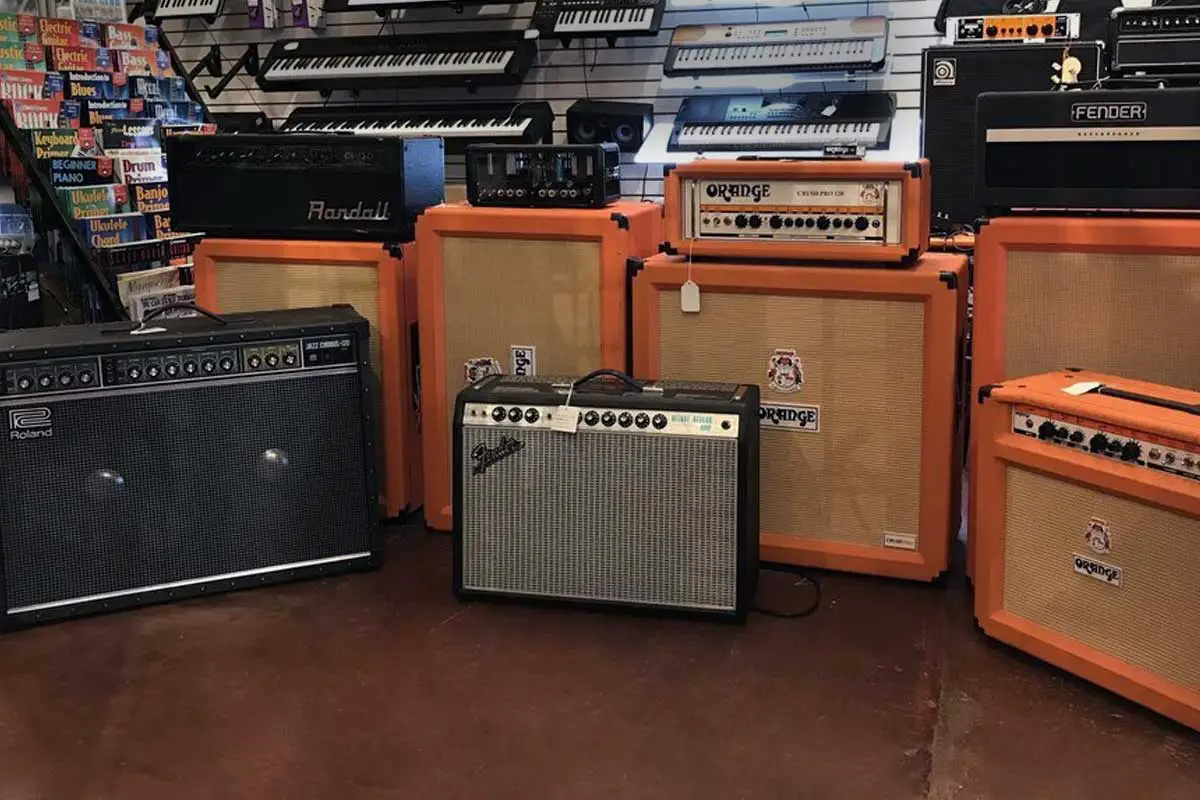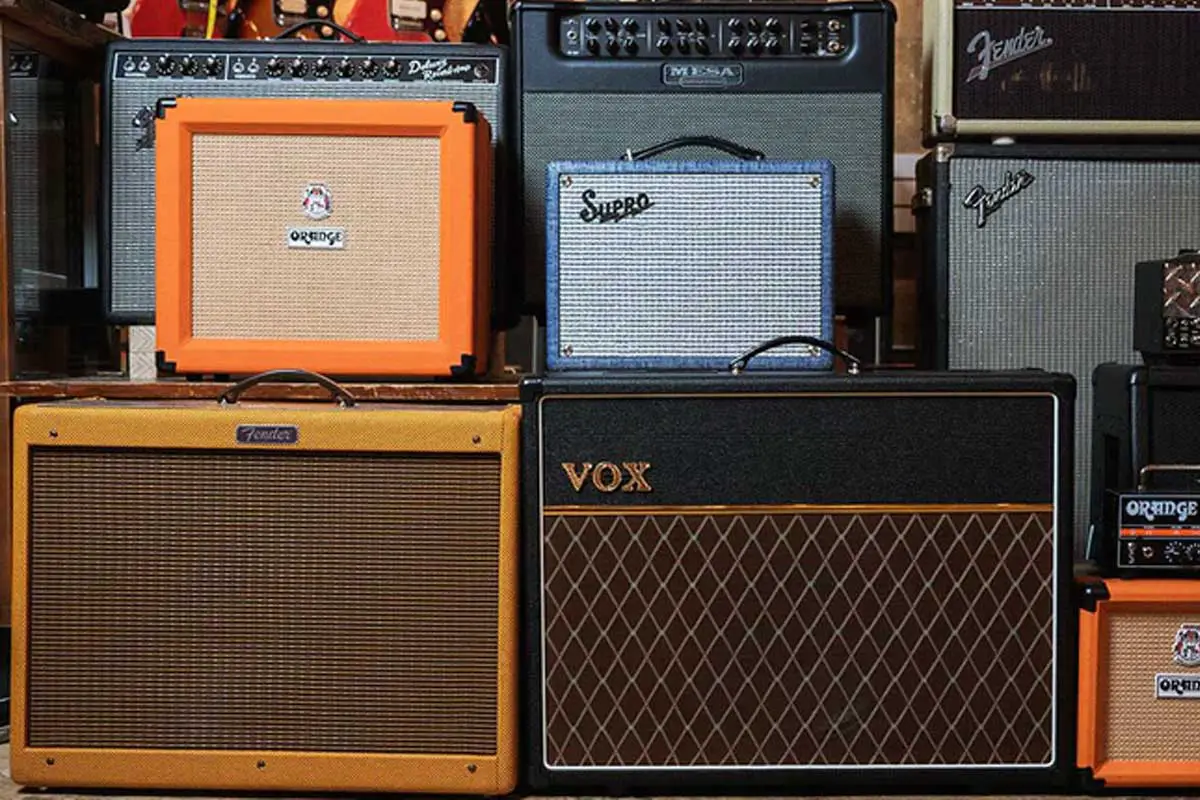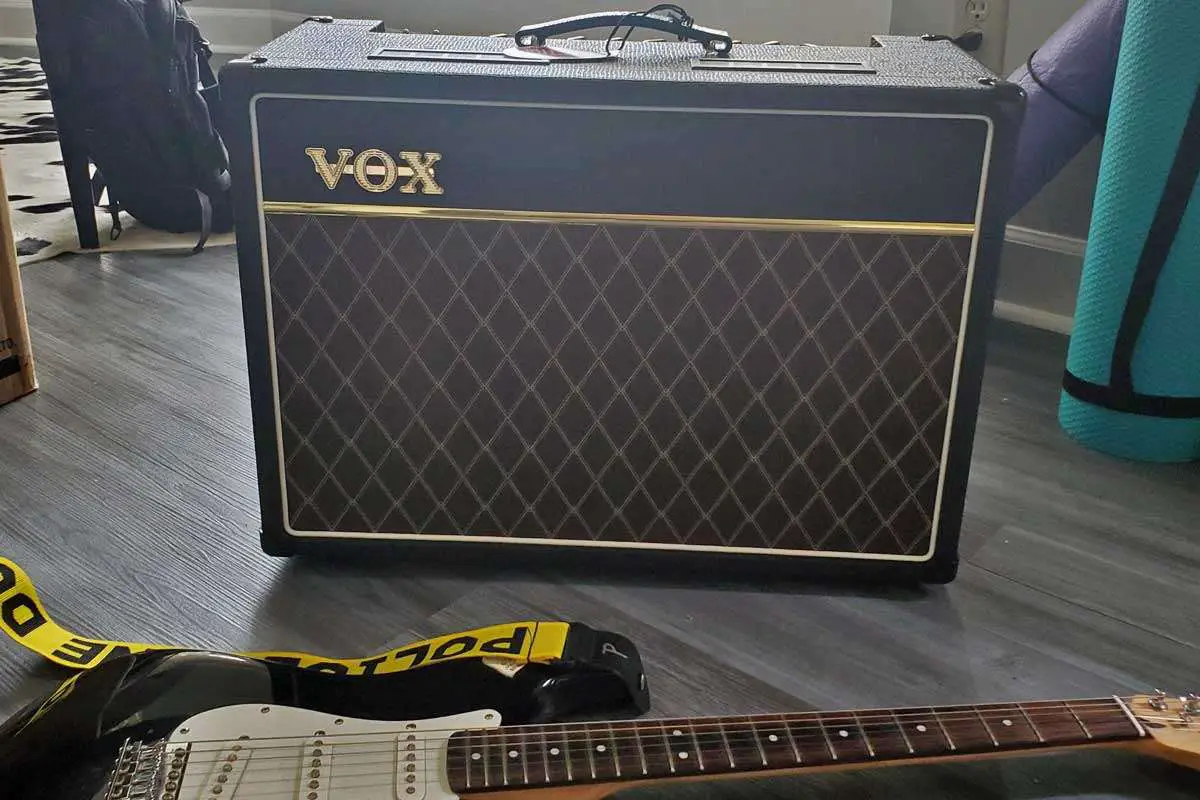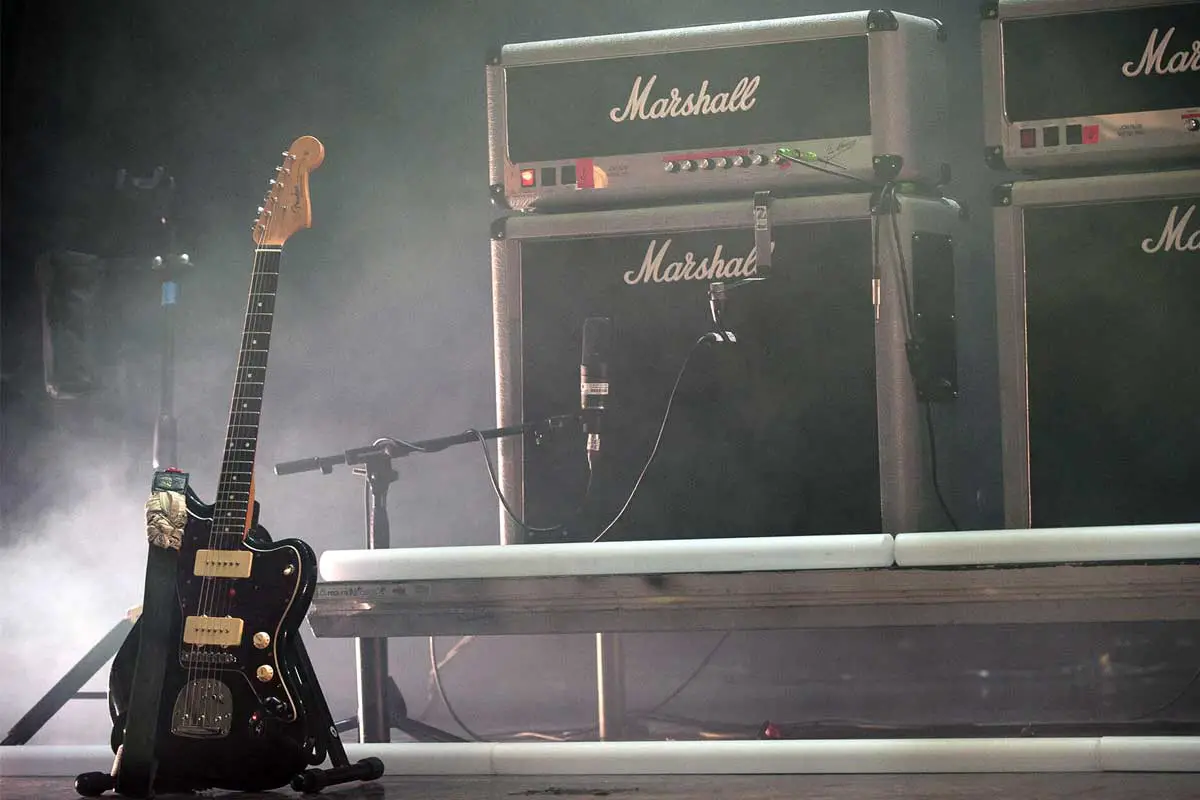If you’re a guitarist, you’ve probably heard of a combo amp. But what is a guitar combo amp exactly, and how does it differ from other types of amplifiers? In short, a combo amp is an all-in-one amplifier and speaker system that is commonly used by guitarists of all skill levels.
Unlike an amp head and cabinet, which are separate components that must be connected together with speaker cables, a combo amp is a self-contained unit that includes both the amplifier and the speaker(s) in a single enclosure. This makes it a convenient and portable option for guitarists who want to take their sound on the go.
Combo amps come in a variety of sizes and power ratings, ranging from small practice amps to large stage-ready models. They typically include a preamp section, which shapes the tone of the guitar signal before it is amplified, and a power amp section, which boosts the signal to a level that can drive the speakers. Some combo amps also include built-in effects like reverb, delay, and distortion, making them a versatile choice for guitarists who want to experiment with different sounds.
Furthermore there are all-tube combo amps, as well as digital ones with modeling capabilities that offer much versatility. In this article we cover more of the basics & go deeper into all the variations you might encounter when getting into playing electric guitar.

Basics & Benefits of Guitar Combo Amps
Guitar combo amps, in essence, are all-in-one amplification solutions that blend the amplifier and speaker components into a single enclosure. Furthermore, they are designed as integrated systems, ensuring that the amplifier and speaker(s) are perfectly matched for optimal performance. This integrated design, combined with built-in features like effects and EQ controls, simplifies the signal chain and minimizes the need for additional pedals or gear.
Additionally, this design simplifies the setup process, enhances portability, and saves space, making them a preferred choice for a wide range of musicians.
Combining both elements into a unified unit also streamlines the gigging experience, especially for those on the move, as they are typically more portable and easier to transport than the traditional head and cab configuration. The convenience factor is notable, as musicians can grab their combo amp with one hand and hit the stage without the hassle of connecting and disconnecting multiple components.
One other key benefit of combo amps is their space-saving nature. For musicians with limited stage or practice space, these compact units prove to be a practical solution.
Furthermore, they are often more cost-effective, making them an attractive choice for beginners and intermediate players seeking reliable sound without straining their budgets while also having to haul less gear around.
In summary, guitar combo amps provide musicians with a package that combines convenience, portability, cost-effectiveness, and integrated design. While they may not be the ideal choice for every guitarist, (especially those looking for that old school “rockstar” look of a separate 100w head & 4×12 cab) their simplicity & ease of use make them a popular modern day option, particularly for those seeking a hassle-free setup and reliable performance.

Types of Guitar Combo Amps
When it comes to guitar combo amps, there are several types to choose from. Each type has its own unique characteristics, so it’s important to know the differences between them to make an informed decision. Here are some of the most common types of guitar combo amps:
Tube Amps
Tube amps, also known as valve amps, are the oldest type of guitar amp. They use vacuum tubes to amplify the sound, which gives them a warm, rich tone. Tube amps are known for their responsiveness and sensitivity to the player’s touch, making them a popular choice for blues, jazz, and classic rock guitarists. They are also louder than solid-state amps, making them a good choice for live performances, but not always practical for home practice if you’re trying to keep volumes down.
Solid State Amps
Solid-state amps use transistors instead of tubes to amplify the sound. They are generally more reliable and less expensive than tube amps, and they also tend to be lighter and more portable. Solid state amps have a clean, crisp tone that is well-suited for genres like country, pop, and metal. They are also less prone to distortion at high volumes which might matter for some.
Digital Modeling Amps
Digital modeling amps use digital signal processing (DSP) technology to simulate the sound of different types of amps and effects. They are a highly versatile subset of solid state amps, allowing you to switch between different amp models and effects with the push of a button. Digital modeling amps are a good choice for guitarists who play a variety of genres, as well as newbies who are looking to find what type of tones they will prefer before investing in more specialized valve amps that might only be suited for certain styles of playing.
Key Components of a Combo Amp
A guitar combo amp is a single unit that houses both the amplifier and the speaker(s) in a single enclosure. Understanding the key components of a combo amp is essential when it comes to selecting the right one for your needs.
Preamp
The preamp is the section of the amplifier that processes the guitar signal before it is amplified. It shapes the tone of the guitar and determines the amount of gain or distortion that is added to the signal. Preamps in valve (tube) amps and solid-state amps differ primarily in their electronic components and the way they handle signal amplification.
Valve amps use vacuum tubes (valves) in their preamp stages, which introduce a warm, organic, and often harmonically rich tone. These tubes can add natural compression and saturation to the signal, resulting in a classic, vintage sound highly favored by many guitarists.
In contrast, solid-state amps utilize semiconductor components like transistors in their preamp sections, offering a cleaner, more linear amplification with less coloration of the original signal. This results in a more pristine and transparent tone without the harmonic distortion characteristics of tube preamps. Ultimately, the choice between valve and solid-state preamps depends on a guitarist’s preference for tonal character, as each technology offers distinct sonic qualities.
Power Amp
The power amp is responsible for amplifying the preamp signal to a level that can drive the speakers. It determines the overall volume of the amp and plays a significant role in shaping the tone. The power amp is often categorized by its wattage, which indicates how much power it can deliver.
Furthermore, the power amp section in valve amps and solid state guitar amps can differ significantly. Valve amps typically have lower wattage ratings than solid state amps, but they often produce a more powerful and dynamic sound. This is because valve amps have a higher headroom, which means they can handle more dynamic range before distorting. Solid state amps, on the other hand, can handle more power and are often used in high-volume settings where a lot of headroom is required. Ultimately, the choice between a valve amp and a solid state amp comes down to personal preference and the specific needs of the guitarist.
Speaker
The speaker is the component that converts the electrical signal from the amplifier into sound waves that you can hear. The size and number of speakers in a combo amp can significantly impact the overall sound and volume. Most combo amps come with either one or two speakers, but some models can have up to four. For at home bedroom use, a single 12″ speaker should provide more than enough volume and even handle some smaller gigs. If you play live often & need some extra punch to cut through the mix, then a 2×12″ combo might be better suited for you.
Effects
Many combo amps come with built-in effects that allow you to add different sounds and textures to your guitar tone. Common effects include reverb, delay, chorus, and distortion. Some models come with a built-in effects loop, which allows you to connect external effects pedals.
When it comes to modeling amps, they can even have various imitations of other amps which can provide a wide range of sounds for almost any playing style.
Overall, the key components of a guitar combo amp are the preamp, power amp, speaker, and sometimes effects (most commonly reverb). Understanding how each of these components works and how they interact with each other is essential when it comes to selecting the right combo amp for your needs.

Brand and Model Considerations
When it comes to choosing a guitar combo amp, there are many brands and models available on the market. Some of the most popular brands include Fender, Blackstar, Marshall, vox, among others – each with their own unique features and characteristics. Here’s a few popular models to consider:
Fender Blues Junior IV: Known for its iconic Fender clean tones and bluesy breakup, the Blues Junior IV is a compact and affordable combo amp. It features a single 12-inch speaker and is prized for its simplicity, making it a great choice for both gigging and recording.
Vox AC15C1: The Vox AC15C1 is famous for its jangly British tone and classic chime. This 15-watt combo amp is equipped with a 12-inch Celestion speaker and has onboard reverb and tremolo effects. It’s a go-to choice for players seeking that distinctive Vox sound.
Marshall DSL40CR: Marshall’s DSL40CR is a versatile combo amp offering both classic and modern rock tones. With 40 watts of power and a Celestion V-Type speaker, it features a gain channel for high-gain sounds and a clean channel for pristine tones. It also includes a digital reverb for added versatility.
Orange Crush 35RT: Orange Crush amps are known for their unique, gritty, and colorful tones. The Crush 35RT is a 35-watt combo with a 10-inch speaker. It stands out for its solid-state simplicity and affordability while delivering a distinctive Orange flavor.
Blackstar HT-5R MkII: The Blackstar HT-5R MkII is a compact 5-watt combo amp that shines for its versatility. It offers a wide range of tones from pristine cleans to high-gain distortion. It also features Blackstar’s patented ISF (Infinite Shape Feature) control, allowing players to dial in British or American-style tones.
When choosing a brand and model, it is important to consider your own personal preferences and playing style. Think about the type of music you play, as well as the venues you perform in, and choose an amp that will give you the best sound and performance.
It is also important to consider the size and power of the amp. For smaller venues and practice sessions, a lower wattage amp may be more appropriate, while larger venues may require a higher wattage amp for maximum volume and projection.
Overall, choosing the right brand and model of guitar combo amp is an important decision that can greatly affect your sound and performance. Take your time, do your research, and try them out in person if you can in order to best suit your needs.
Factors to Consider When Choosing a Combo Amp
When choosing a combo amp, there are several factors to consider that will help you find the right one for your needs. Here are some important things to keep in mind:
Wattage
When choosing a combo amp, the wattage needed can vary depending on whether you are considering a solid-state or valve amp. Valve amps tend to have a more natural compression that allows them to sound louder than their wattage rating suggests. For example, a 15-watt valve amp can be as loud as a 30-watt solid-state amp. Therefore, a lower wattage (around 15-30 watts) may be sufficient for practicing or small gigs with a valve amp.
Solid-state amps, on the other hand, require more wattage to achieve the same volume as a valve amp due to their design. For example, a 100-watt solid-state amp may be necessary for playing in a band or performing live. However, for practicing at home, a lower wattage (around 10-20 watts) may be sufficient for both solid-state and valve amps.
Weight & Portability
Weight and portability are important factors to consider when choosing a guitar combo amp. If you plan on traveling with your amp or taking it to gigs, a lightweight and portable amp will be much more convenient to transport. A heavy and bulky amp can be difficult to move around and may require extra equipment to transport, such as a dolly or cart.
Additionally, a portable amp can be easier to store in a smaller space, such as a practice room or apartment. However, it’s important to note that a smaller and more portable amp may sacrifice some of the power and features of a larger amp. Therefore, it’s important to find a balance between portability and performance when choosing a guitar combo amp.
Number of Channels
A channel is essentially a separate input on the amp that allows you to switch between different sounds or tones. For example, a two-channel amp allows you to switch between a clean and a distorted sound. A three-channel amp may have a clean, crunch, and lead channel.
Having multiple channels can be useful for expanding your tonal options and creating a more versatile sound. However, it’s important to note that having more channels can also make the amp more complex to use and may require more time to dial in the desired tone. This might not be a bad thing if you like to tinker with all the possible sounds an amp can make & really dial in a signature tone for yourself.
Additionally, having more channels may increase the cost of the amp in some cases. Therefore, it’s important to consider the number of channels you need based on your playing style and preferences. If you decide on a single channel option without distortion or effects, you might have to purchase FX pedals later down the road in order to customize your sound.
Speaker Size & Configuration
The choice of speaker size and configuration is a critical factor when selecting a guitar combo amp, as it profoundly impacts your overall tone and sonic versatility. Speaker size matters because it determines the amp’s ability to reproduce different frequency ranges.
Larger speakers, such as 12-inch or 15-inch models, excel at delivering deep, resonant bass frequencies, making them well-suited for genres like rock and blues where a full-bodied sound is desired. Conversely, smaller speakers like 8-inch or 10-inch ones produce a tighter, more focused response, ideal for styles such as jazz or country, where articulation and punch are essential.
When considering speaker configuration, remember that a single speaker provides a straightforward, centralized sound projection, while multiple speakers in a 2×12 or 4×10 setup disperse sound more broadly, offering a wider soundstage for larger venues. Therefore, the speaker size and configuration should align with your musical preferences, playing style, and the types of venues you frequent, as they greatly contribute to your amp’s tonal versatility and stage presence.
Finally, the choice between closed-back and open-back configurations significantly influences your amp’s sound. Closed-back cabinets provide a more controlled sound with enhanced bass response, making them suitable for genres requiring tight low-end precision, like metal or hard rock. In contrast, open-back cabinets create a more spacious, airy sound with a less pronounced bass response, making them ideal for styles where a more ambient or vintage tone is desired, such as blues or indie rock. The choice between closed and open-back configurations should be guided by the tonal characteristics you seek and how well they complement your playing style & genre preferences.
Onboard Effects
Finally, we have onboard effects which can also be a significant factor in your gear choice. When considering these built-in effects, it’s essential to look for diversity and quality. Having a variety of effects like reverb, delay, chorus, and overdrive built into your amp can provide convenience and versatility, especially for players looking to streamline their setup.
It can be beneficial for quick tone shaping during practice or performance without the need for external pedals. However, it’s important to note that the quality and flexibility of onboard effects can vary widely among different amp models. Some combo amps offer studio-grade effects with extensive control options, while others may provide basic, one-size-fits-all effects.
The decision between onboard effects and external pedals depends on your preferences. While onboard effects offer convenience, dedicated pedals offer greater customization, higher quality, and the ability to fine-tune your tone precisely to your liking. Many guitarists find a combination of both onboard effects and external pedals to be the ideal balance, allowing them to access a wide range of sounds while maintaining control and sonic quality. Ultimately, the choice depends on your specific needs, playing style, and how much you value the convenience of onboard effects versus the depth and flexibility of dedicated pedals.

Comparison with Other Amplification Options
When it comes to amplifying your guitar, there are a few different options to consider. In this section, we’ll compare combo amps to two other popular options: head and cab setups and full stacks.
Head & Cab
Guitar combo amps and a head & cab pairing represent two distinct approaches to amplifying your guitar, each with its set of pros and cons.
Combo amps are self-contained units, combining the amplifier and speaker(s) into a single enclosure. They are generally more compact, portable, and user-friendly, making them an excellent choice for first-time players. Combos are cost-effective and easy to set up, eliminating the complexities of matching heads and cabs. However, they may have limited tonal options or simply a more modern sound and difference in power compared to head & cab setups.
Head & cab pairings offer greater flexibility and customization. Players can mix and match different amplifier heads with various speaker cabinets to fine-tune their desired sound. This setup provides more power, tonal nuances, and versatility but comes with added complexity, cost, and transportation considerations. It’s a preferred choice for experienced players who prioritize tonal exploration.
For a first-time player, a combo amp is often the most straightforward and budget-friendly option. It provides an all-in-one solution, allowing beginners to focus on learning and playing the guitar without getting overwhelmed by the intricacies of separate head & cab configurations. As players gain experience and specific tonal preferences, they can then explore the more nuanced world of head & cab setups.
Full Stack
A full stack is when you use two speaker cabinets with a separate amplifier head. This setup can give you even more power and volume than a head and cab, but it’s also even more expensive and less portable.
One advantage of a full stack is that it can look impressive on stage, which can be useful if you’re going for a certain aesthetic. Additionally, this setup can give you a lot of control over your tone, as you can mix and match different cabs to achieve your desired sound.
However, a full stack can be extremely heavy and difficult to transport. You’ll need to bring both cabs and the head with you, which can be a hassle if you’re traveling frequently. Additionally, this setup can be very expensive, as you’ll need to purchase both cabs and a head.
Overall, there are pros and cons to each of these amplification options. Combo amps are generally the most portable and affordable, while head and cab setups and full stacks can give you more power and control over your tone. Ultimately, the best option for you will depend on your specific needs and preferences.
Related: What Is A Rhythm Guitar?
Conclusion
Now that you have a good understanding of what a guitar combo amp is, you can make an informed decision on which one to purchase. When it comes to quality, you generally get what you pay for. Higher-end combo amps tend to have better components and construction, resulting in better sound and durability. However, solid state amps have gotten better over the years & into smaller packages which make them a great budget option that can provide decent sound without breaking the bank.
When it comes to style, there are plenty of options available to suit your personal taste. Whether you prefer a vintage look or a modern design, you can find a combo amp that fits your style. Additionally, some combo amps offer more flexibility than others. Look for amps with multiple channels, modeling technology, built-in effects, and other features that allow you to tailor your sound to your liking.
Ultimately, the ideal guitar combo amp for you will depend on your specific needs and preferences. Take into consideration your playing style, the venues you’ll be performing in, and the type of music you’ll be playing. With a little research and experimentation, you’ll be able to find the perfect combo amp that meets all of your needs.
Related: Why Do Guitarists Wear Wristbands?
